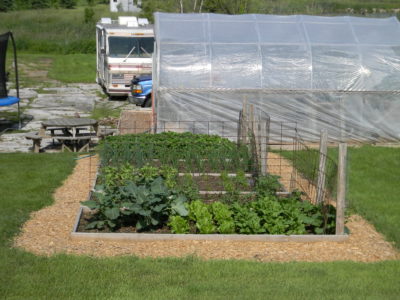Everybody’s putting in raised beds these days and there is a reason for that. Raised garden beds are easy to make and easy to care for, making them very popular for working families wanting to grow their own food. But there are things you need to know before you start your own raised bed.
- Try to find full sun. Look for the sunniest spot in your yard. Keep in mind that trees grow, and they use a lot of groundwater. You can always use tall veggies to shade your temperamental plants.
- Look for the lowest spot in your yard. No matter how much you water your garden, nothing beats good old rainwater, and the lowest spot in your yard will usually find the most water in a rain. We had a spot that was always wet. I had trouble mowing it most of the year, so we put our raised beds right over the wet spot. Our tomatoes, broccoli, and onions love it there, and I hardly ever have to water them.
- Build long, skinny beds, and point them north and south. 4’x10’ boxes work well for us, as we can reach across them easily to weed. Put climbing plants such as cucumbers, beans, and snap peas on the north end of your gardens, using two posts and wire fence. We use hog panel, cut so the bottom of the fence has spikes, driving them into the ground for sturdiness. Use compost, dirt, and mulch to get just the right soil for your produce, and don’t scrimp on this. Make sure the soil is loose. It may be a lot of work and cost at first, but your plants will love you for it.
- Decide what you want to plant and remember what doesn’t work well in raised beds. Potatoes, sweet corn, melons, pumpkins, and squash use up a lot of ground, so it is not feasible for us to plant them in our raised beds. We make separate 4’x4’ boxes for these, out where they can run into the grass and spill over. We have five raised beds, and we plant tomatoes, broccoli, carrots, onions, radishes, strawberries, lettuce, and spinach in them. On each north trellis we plant cucumbers, okra, green beans, and snap peas. With this crop, we can 40 quarts of pickles, 20 quarts of beans, 50 quarts of tomato sauce, and we freeze a lot of okra. Lettuce doesn’t like full sun, so we plant broccoli in the south end of a bed, then lettuce in the north. This way, the broccoli shades the lettuce. It’s the same with snap peas. We put tomato plants in the bed so they shade the north trellis where the peas grow.
- Mulch around your raised beds, and leave at least 16 inches between each bed. This allows you a clean, wide path to kneel on while you tend your garden. Mulch has proven to be the best surface for our pathways, and it‘s very easy to care for, dissolving into earth as it ages. We bring a kneeling cushion out, and it only takes a few minutes to tend each bed. I pick one bed to weed each weeknight, and even when I am picking produce, I am done in no time at all.
Most of all, only grow what you and your family likes. By experimenting each year, you will quickly optimize your garden space. Remember, raised beds only do well with certain vegetables. And have fun! Get your kids out each day, have them pick produce, pull weeds, and even help you freeze and can. They will remember their garden time forever, and you will help carry on the tradition of being self-supporting to the next generation.
 Off The Grid News Better Ideas For Off The Grid Living
Off The Grid News Better Ideas For Off The Grid Living





